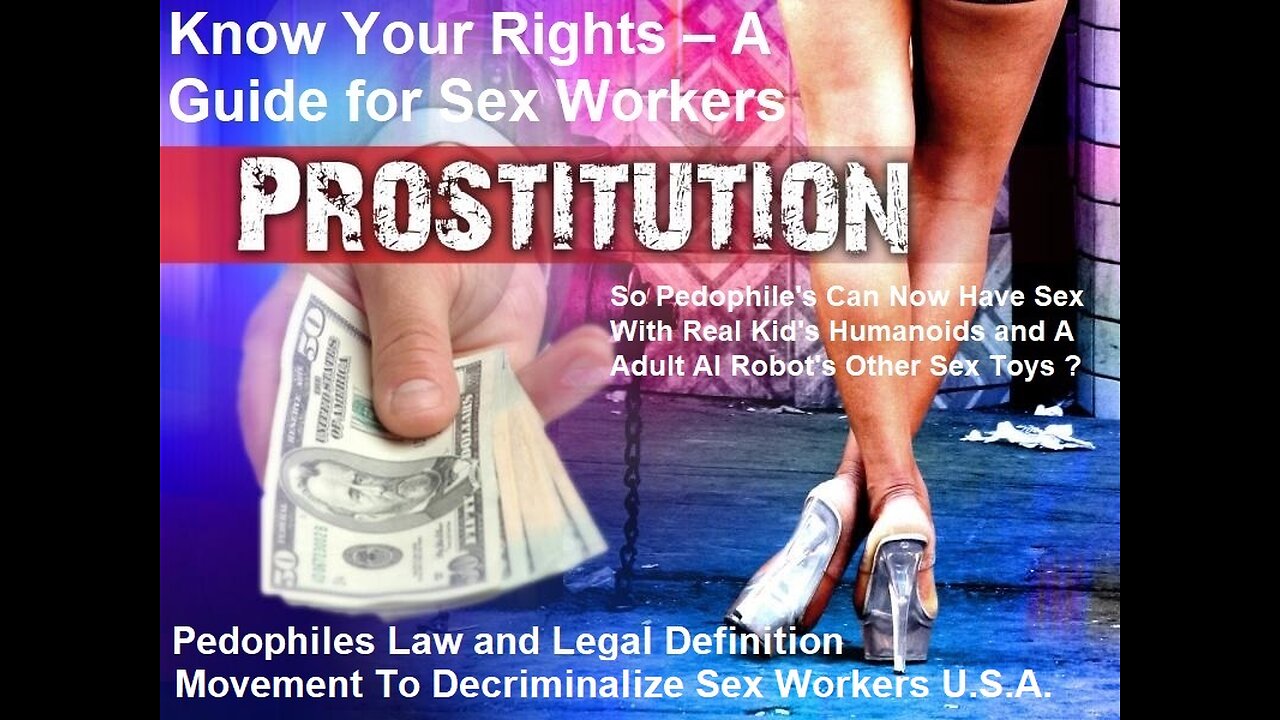Premium Only Content

Can Pedophile's Have Sex With Real Kid's Humanoids and Other Adult AI Robot's ?
Pedophiles are people with a sexual attraction to children. Manifest acts, such as taking sexually explicit photographs, molesting children and exposing one's genitalia to children, are all crimes. Pedophiles can be "treated" but never cured, because their sexual preference has always been, and always will be, children. Their urges will always be present. Therefore, treatment focuses on changing, curbing, or re-directing the acting-out behaviors of pedophiles.
Many states have laws requiring convicted pedophiles to be registered as a sex offender in the community where they reside. The purpose of such laws is to alert the public so that children in the neighboring area are aware of the need to safeguard themselves. A “AI-Driven Sex Robots” are the robots designed for humans to have sexual intercourse. It is a machine engineered for sexual simulation and stimulation. If this sounds a bit mechanical and crass, it’s because, well, it sort of is. That being said, a major facet of human sexual intercourse is mechanical — so much so that prescribing tool analogies to our descriptions of it have become part of our popular cultural lexicon.
The sex industry has been at the forefront of the implementation of innovative technologies, and integrating AI is unlikely to be an exception. Sexbots are increasingly complex technologies that combine advances in robotics and artificial intelligence. Their artificial emotional intimacy is powered by artificial intelligence and some AI applications already seek to mimic human dynamics. In the following, we will discuss the Best AI-Driven Sex Robots to Help You Achieve Orgasm.
Sex workers have been fighting for decriminalization for generations. Now politicians are starting to listen. “Everybody has sex,” says Tamika Spellman. “The only difference is that we charge for it.”
Spellman has been a sex worker in Washington, DC, for more than 30 years. In that time, she’s faced a stream of abusive behavior from police.
“I’ve had them call me names, tell me that I was stupid, that whatever happened to me out there, I deserved it for being out there,” she told Vox.
Officers have made comments like, “it would be all right if you were out here working, so long as I get lunch,” Spellman said, essentially forcing her to buy them a meal to avoid being arrested.
She’s also been sexually assaulted by officers, she told Vox. “This is something that you can find across the board with sex workers,” she said. Police “take advantage of us.”
Then there is the financial toll of criminalization. Repeated arrests and fines for doing sex work have driven Spellman further into poverty. She’s currently homeless.
Criminal penalties can take a toll on sex workers’ families too. Spellman’s children are grown now, with children of their own — she even has a great-grandchild. But when they were young, she said, “those arrests really took away from my babies.”
The solution, for Spellman and other sex workers’ rights advocates, is decriminalization: the removal of criminal penalties for selling and buying sex. Advocates say getting rid of those penalties is the only way to keep sex workers safe from police harassment and the damaging effects of arrests and fines and to guarantee them full human rights as workers in America.
Activists have been pushing for decriminalization worldwide for years, and they’ve had some successes: New Zealand removed criminal penalties in 2003, and Amnesty International called on all countries to do so in 2016. But in the United States, where buying and selling sex is illegal everywhere except for a few counties in Nevada, decriminalization has been a tougher sell.
That’s starting to change, though, thanks to a combination of sex worker activism, increased attention to racial justice and workers’ rights and, perhaps, backlash to the 2016 election. Recently, legislation to decriminalize sex work has been introduced in both DC and New York state, and several presidential candidates, including Sens. Cory Booker and Kamala Harris, have said they support some degree of decriminalization.
The decriminalization effort has a lot of work ahead of it — most states have yet to make any moves on the issue. But sex workers are closer than perhaps ever before to winning the right to do their jobs without fear of arrest.
“It needs to happen,” says Spellman, who also works with the service and advocacy organization HIPS. “It deserves to happen.”
The movement for decriminalization is far from new
Sex workers face stigma and prosecution in the US and around the world. As Molly Smith and Juno Mac write in their 2018 book Revolting Prostitutes: The Fight for Sex Workers’ Rights, tens of thousands of people are “arrested, prosecuted, incarcerated, deported, or fined” for sex work-related offenses in the US every year. In a 2003 survey of street-based sex workers in New York City, 80 percent said they had been threatened with or experienced violence, and many said the police were no help. In fact, 27 percent of respondents in the survey said they had experienced violence from police officers.
“If I call them, they don’t come. If I have a situation in the street, forget it,” one respondent said. “After a girl was gang raped, they said, ‘Forget it, she works in the street.’”
These problems are longstanding, and people who sell sex have been advocating for their rights in America for generations. In 1917, for example, more than 200 prostitutes marched on Central Methodist Church in San Francisco to protest an anti-prostitution campaign led by the church’s pastor. In the 1960s, sex workers were part of the Compton’s Cafeteria riot and the Stonewall uprising, landmark events in the fight for LGBTQ rights.
But the sex workers’ rights movement as it exists today has its roots in the 1970s, with the founding of groups like COYOTE (Call Off Your Old Tired Ethics) that advocated for an end to laws targeting sex workers, journalist Melissa Gira Grant writes in her book Playing the Whore: The Work of Sex Work.
“The usage of the term ‘sex work’ marks the beginning of a movement,” wrote activist Carol Leigh, who coined the term in 1978. “It acknowledges the work we do rather than defines us by our status.”
Over time, “sex work” started being used by health and advocacy organizations, as well as the media, according to the Global Network of Sex Work Projects. Today, it’s used to describe sex as a form of labor, Smith, who’s also a sex workers’ rights organizer, told Vox. “It’s about situating it within a framework of workers’ rights,” a framework under which workers advocate together for economic, racial, and gender justice, she explained. (Some sex workers use the term “prostitute” to refer to themselves, while others do not.)
A major part of the fight for sex workers’ rights has been a push for decriminalization, or removal of criminal penalties for selling and buying sex. In general, “prostitution remains illegal and criminalized across the country,” Kate Mogulescu, an assistant professor of clinical law at Brooklyn Law School, told Vox. But there is no federal law banning sex work, and laws vary from state to state and even city to city, says Mogulescu, who also directs a clinic focused on representing people charged with sex work-related offenses.
In some states, such as Arizona and Florida, repeated arrests for doing sex work can result in a felony conviction and prison time. Until 2011, some people arrested for doing sex work in Louisiana were forced to register as sex offenders. In other states, like New York, sex work-related offenses are misdemeanors, punishable with fines and other penalties. But even then, people arrested on sex work charges may be jailed until trial if they can’t make bail, as Mac and Smith note in Revolting Prostitutes. They also point to one county in Virginia where a jail was forced to bring in 200 rollout beds to accommodate a crackdown on prostitution.
The only state where sex work is legal in some counties is Nevada, but the counties must have fewer than 700,000 residents — this excludes Clark County, where Las Vegas is located. Even in the legal counties, the sector is highly regulated — sex workers can only work in licensed brothels and must be tested regularly for sexually transmitted infections.
Mistress Matisse, a dominatrix and writer, described working in a Nevada brothel as a restrictive experience. “You had to be in the brothel 24/7,” she told the New York Times in 2016. “It was like a cross between summer camp and a women’s prison.” Most prostitution in Nevada still takes place illegally, outside the brothels, the Times reported.
Meanwhile, some draw a contrast between laws against sex work and those around pornography, which often requires people to have sex for money on camera. Though authorities in the past have tried to charge pornography producers under anti-prostitution laws, a 1988 California Supreme Court case found that pornography did not violate those laws.
“We have a very robust porn industry,” Spellman said, “but then we still have restrictions on selling sex. Is that not the same thing?”
Advocates say criminalization puts sex workers in danger
Sex workers’ rights advocates have long argued that “criminalization of sex work makes people who are in the commercial sex industry less safe,” as Mogulescu puts it. In particular, criminalization forces sex workers “to move their work or structure their work in such a way as to avoid police contact,” she explained.
Avoiding police might mean sex workers need to go to more remote locations, which can be more dangerous. Working in the same space can help sex workers stay safe, but some anti-prostitution laws make that illegal, or even expose workers who share space to more severe charges like promoting or profiting from prostitution, Mogulescu said.
Criminalization of sex work also puts sex workers at risk of police violence, according to Jessica Raven, a steering committee member with the New York advocacy coalition DecrimNY. In one 2008 study, nearly one in five sex workers and people profiled as sex workers said they had been asked for sex by a police officer, and one respondent said she had been “made to perform sexual favors to avoid being charged with prostitution.”
People of color are significantly more likely to be arrested for sex work-related offenses than white people. According to Amnesty International, nearly 40 percent of adults and 60 percent of youth arrested for prostitution in the US in 2015 were black, even though black Americans only make up about 12 percent of the US population.
Trans women are also especially likely to be arrested on sex work charges, even if they’re not doing sex work, advocates say. A law against “loitering for the purpose of engaging in prostitution” in New York state has been nicknamed the “walking while trans” law, because advocates say trans women are routinely arrested under the law for doing nothing more than walking in public. In certain areas of New York City, “you cannot be a trans woman of color standing on the street without risking arrest,” Mogulescu said.
In addition to exposing people to police violence, sex work arrests can take a toll on workers’ ability to support themselves and their families. “A lot of times the courts are imposing fines and restitution on someone that’s already impoverished,” Spellman said. In Washington, DC, fines can be as much as $500 for a first offense.
Being convicted of sex work–related offenses also gives sex workers a criminal record, which can make it hard to find housing or non–sex work employment. This falls especially hard on trans women of color, who already face employment discrimination. In a 2015 survey by the DC Trans Coalition, more than 40 percent of trans respondents said they’d been denied a job because of their gender identity, and 55 percent of black trans respondents were unemployed.
“If I could get a normal job as a black transgender woman that paid me sufficiently, that would make a bit of difference,” Spellman said. But “our government has chosen to continue to criminalize people instead of increasing resources, expanding opportunities, and giving people the ability to thrive.”
Sex workers’ rights movements have had some successes abroad
The sex workers’ rights movement worldwide has had a few wins. In 2003, for instance, New Zealand decriminalized prostitution, removing penalties for buying and selling sex. A 2008 study found that after decriminalization, sex workers felt more comfortable reporting abuse to police and more able to insist on safer sex practices and refuse unwanted clients.
Other countries have adopted what is known as the “Nordic model,” which eliminates criminal penalties for selling sex but retains penalties for buyers. Sweden took such an approach in 1999, and several other countries, including Norway, have adopted the model since then.
While some feminist groups support Sweden’s approach, sex workers’ rights groups say the Nordic model still hurts sex workers. Because it keeps the sex trade underground, criminalizing the buying of sex exposes workers to many of the same harms as criminalizing the sale, Mogulescu says. And Nina Luo, a steering committee member at DecrimNY, says that Nordic-model countries have enacted a number of policies that are harmful to sex workers, like campaigns to evict them from their homes.
“When you claim to decriminalize the sex worker but are still criminalizing everything else in their lives, you are still making their lives dangerous,” Luo said.
Increasingly, global health and justice groups are calling for full decriminalization of sex work. In 2012, the World Health Organization recommended that countries work toward decriminalization. Amnesty International made a similar recommendation in 2016.
The United States, however, saw little movement toward decriminalization for years. In fact, 2018 federal legislation known as FOSTA-SESTA (a combination of two bills, the Allow States and Victims to Fight Online Sex Trafficking Act and the Stop Enabling Sex Traffickers Act) has been criticized by many sex workers’ rights groups. The law is meant to penalize websites for hosting content linked to sex trafficking, but in practice, it limits sex workers’ ability to advertise their services online, forcing them into more dangerous street-based work, Raven said.
Now decriminalization is becoming an election issue
However, things are beginning to change. A bill to decriminalize prostitution in DC was introduced in 2017. It didn’t pass, but it’s since been reintroduced, and advocates expect it to get a hearing in the fall.
Earlier this year, Democrats in the New York state legislature also introduced bills, backed by Decrim NY, to decriminalize prostitution and repeal the state loitering law. The bills didn’t pass, but Decrim NY expects them to be reintroduced in the next legislative session, Luo said. The legislation also got significant media attention, with coverage in the New York Times, the New Republic, and elsewhere.
Some feminist and anti-trafficking organizations have criticized the New York bill. Sonia Ossorio, president of the National Organization for Women’s New York City chapter, told Vox the group supports decriminalizing the selling of sex, calling it “ground zero for everybody who works in human rights.” But she voiced concerns about decriminalizing buying. “A movement to fully decriminalize the sex trade so that we normalize male entitlement to sex is not a model of equality,” she said. “It’s not a future that most people want or a future that parents want for their children.”
Sex workers’ rights groups, along with other progressive activists like Women’s March co-chair Bob Bland, have pushed back on NOW’s position. When NOW and other groups held a protest against the New York bill earlier this year, sex workers staged a counterprotest. “It’s important for us to be here because we are consensual sex workers, and the idea that sex work can never be consensual is just wrong,” one of the counterprotesters told the Daily Beast.
Meanwhile, political candidates are starting to run on platforms that include decriminalization. New York state Sen. Julia Salazar made the issue part of her winning 2018 primary campaign to unseat incumbent state Sen. Martin Malave Dilan, as Matt Cohen reports at Mother Jones; she is one of the sponsors of New York’s decriminalization bill. Tiffany Cabán ran for district attorney in Queens this year on a platform including decriminalization, and garnered the endorsement of New York Rep. Alexandria Ocasio-Cortez; after a recount, Cabán’s opponent was declared the winner, but Cabán is challenging the results.
And five Democratic presidential candidates — Sens. Booker and Harris, Reps. Seth Moulton and Tulsi Gabbard, and former Sen. Mike Gravel — have said they support at least partial decriminalization, according to BuzzFeed News. (Some greeted Harris’s comments with skepticism given her history of opposing decriminalization, and she has not yet said whether she supports removing criminal penalties for buyers.) Several others, including Sens. Elizabeth Warren and Bernie Sanders, have said they are open to such a policy.
The issue has entered the political mainstream in a few short years thanks to a confluence of factors, advocates say. “I think we got here through the rise of social justice movements and the left,” said DecrimNY’s Luo. She credits the longstanding advocacy of sex workers’ rights groups as well as the more recent rise of progressive movements like Black Lives Matter. “If you’re a young woman of color who’s worked in immigrant rights, reproductive justice, or labor spaces,” Luo said, “you already get it” on decriminalization.
Raven adds that “after the 2016 election, people were mobilized in a way I’d never seen before.”
“The fact that people are more likely to resist Trump’s policies helped us in a way,” she said.
As the presidential campaign continues, Raven calls on Democratic candidates “to be specific about supporting decriminalization, not partial criminalization, and to recognize that criminalizing buying sex hurts sex workers.”
Spellman wants to see the same. For those who haven’t heard much about decriminalization before, she has a message: “I am not a nefarious person. I’m just your ordinary next-door neighbor.”
Should Pedophiles Be Able to Own Sex Dolls That Look Like Children ?
You’ve seen this on Law and Order: Special Victims Unit multiple times: a person confesses to law enforcement or their medical provider that they struggle with sexual urges aimed at minors. They haven’t hurt anyone yet, but they’re asking for help coping with these thoughts. What should society do in this instance?
Stop SO, a Welsh charity devoted to preventing and stopping sexual assault through therapy, suggested this week that pedophiles might benefit from the use of child-like sex dolls, which the charity proposes they obtain with a psychiatrist’s prescription. The logic here is that sexual fantasies, when experimented with in private and through solo acts, can be lessened in urgency. By substituting a sex doll or robot in place of a human child, the charity suggests, we may be able to save children from being victimized.
The organization made its controversial suggestion when 100 sex dolls fashioned to look like pre-pubescent children were intercepted by border authorities, on their way into Wales after being purchased on eBay and Alibaba.com. According to Wales Online, “The NSPCC and the National Crime Agency have both called for the dolls to be criminalized and rejected claims they can be used to treat pedophiles.”
Juliet Grayson, chair at Stop SO, told Metro UK, “Society needs to reach a point where a teenager can say to his [mother], ‘I am a pedophile’, and she will get him the right kind of help to manage his behaviors in pro-social ways.” David Davies, a member of parliament in Wales, spoke out with some vitriol in response to Grayson’s comments, saying, “Anyone with an ounce of common sense can see these things are quite obscene and should not be allowed into the country, and there is not much I can add to that.” So what does the research tell us?
It’s difficult to make any over-arching statements on pedophilia, partially because the concept is so deeply taboo that researchers have a hard time funding their studies. We’re talking about a population which, upon getting the shit beat out of them in prison, incites glee in most Americans who love to see “evil” punished. To Catch a Predator, Dateline NBC’s on-camera sting operation, revealed the faces of active pedophiles to a thrilled audience of millions from 2004 to 2007.
In 2014, The New York Times estimated that 1% of the globe’s male population remains sexually attracted to pre-pubescent children after going through puberty themselves. There are several places where self-professed “virtuous” or harmless pedophiles gather to compare stories online, though assumedly many of them don’t disclose their urges online at all, in fear of being found out. Many porn categories, including the Japanese loli (banned from Reddit by name) and mainstream porn search functions like “teen” and “barely legal” scratch that itch using adult actresses in fake braces and pigtails, or artist-renderings of children’s bodies. Like the use of child-like sex dolls, watching animated porn, or pornography depicting adult actors pretending to be children, still exists in that uncomfortable place between illegality and the deeply taboo.
Prescribing a pliable, childlike form to pedophiles is, though not an active practice, merely a way of trying to placate urges without aiming for a “cure”. Then again, psychiatry hasn’t come up with a system that consistently rehabilitates pedophiles, though Dr. Richard Krueger, the medical director of the Sexual Behavior Clinic at New York State Psychiatric Institute in New York, says pedophiles of different types respond differently to treatments. Patients who express sexual interest in post-pubescent young people in addition to children can be, as Krueger told Live Science “nudged” in the direction of desiring only adults. Those who find themselves attracted solely to children are, Krueger believes, untreatable so far. “In these situations,” he says, “pretty much you can only repress things, and you would use androgen therapy to do this.”
For now, there are no legal changes being made to the state of child-like sex dolls in Wales, or anywhere else in the world. If we one day issue these dolls to self-professed pedophiles, it’ll take a lot over societal and legal overhaul.
Sex Robot CEO Says Some Customers are "Men Going Their Own Way"
Many Real Doll customers are men who have deliberately made the choice to remove real women from their lives, says Matt McMullen, CEO of Abyss Creations, a company that makes the realistic sex mannequins. At least, those men say it was deliberate.
McMullen told Mel Magazine that he understands their choices to court animatronic sex toys over real women. “For a guy who’s already foreseeing a messy divorce and thinking, ‘I don’t want to spend my money on that,’ this makes perfect sense,” he says.
Having eschewed human women, these men are turning to companies like Real Doll, which integrates a rudimentary artificial intelligence personality into robotic sex puppets.
The group, which calls itself Men Going Their Own Way or MGTOW, claims the financial and emotional burdens of marriage, divorce, and infidelity outweigh the benefits of human relationships. A part of the men’s rights movement, its members hope sex-bots will provide fulfilling relationships and, in the misogynistic words of MGTOW acolyte and far-right provocateur Milo Yiannopoulos, “won’t be programmed to whine endlessly about the wage gap.”
In 1997, McMullen decided to take his hobby of sculpting figures of women in his garage to the next level, founding Abyss Creations in San Marco, California. He says that once Real Doll 3.0, which he has named “Harmony,” launches, it will be more about intelligence and personality. He hopes that customers will be so inspired that they see Harmony as a muse and take up sex robot photography or painting of sex robots. While there’s no price tag set for Real Doll 3.0 yet, previous models cost just under $15,000.
For McMullen, Abyss Creations is about creating artificial intelligence sex robots that are so life-like, people treat them like the partners they’ve chosen to avoid.
But Harmony’s personality is still rudimentary: The allegedly meaningful interactions she simulates involve various personality settings that range from “jealous” to “giving.”
This might be enough for the men’s rights activists who celebrate the future of sex-bots. Based on their discussions on Reddit, they seem to want the robot to be as lifelike as possible, just so long as they can’t complain or be unhappy. They’re excited about the prospect that Harmony can remember their favorite food, and seem fine with that being the extent of their relationship.
While romantic relationships are not for everybody — many aromatic or asexual people don’t feel the need to find a partner — the reason men’s rights activists are choosing Real Dolls over women is altogether different. They are more interested in turning sexuality into a video game designed solely for male enjoyment where they can compliment Harmony simply to raise its “desire meter.”
McMullen argues criticisms of Real Doll are unwarranted, suggesting a lifelike sex doll could help lonely people who are intimidated by interpersonal interactions. Not all customers are men’s rights activists and could just want to try something new or become more comfortable with their own sexuality. But he didn’t respond to the critique that Harmony can only offer an illusion of empathy or that partnering up with a sex doll will allow men’s rights activists to further dehumanize and justify violence against women.
Prostitution and Exploitation of Kid's Humanoids Adult AI Robot's Prostitution.
Overall approach to the prosecution of Prostitution
The CPS focuses on the prosecution of those who force others into prostitution, exploit, abuse and harm them. Our joint approach with the police, with the support of other agencies, is to help those involved in prostitution to develop routes out.
The context is frequently one of abuse of power, used by those that incite and control prostitution - the majority of whom are men - to control the sellers of sex - the majority of whom are women. However CPS recognizes that these offences can be targeted at all victims, regardless of gender.
The CPS charging practice is to tackle those who recruit others into prostitution for their own gain or someone else’s, by charging offences of causing, inciting or controlling prostitution for gain, or trafficking for sexual exploitation. In addition to attracting significant sentences, these offences also provide opportunities for seizure of assets through Proceeds of Crime Act orders and the application of Trafficking Prevention Orders.
For those offences which are summary only (loitering and soliciting, kerb crawling, paying for sexual services and advertising prostitution) the police retain the discretion not to arrest or report to the CPS those suspected of committing an offence, or they can charge the offence without reference to a prosecutor, regardless of whether the suspect intends to plead guilty or not guilty.
Introduction
This guidance provides practical and legal guidance to Prosecutors dealing with prostitution-related offences.
Prostitution is addressed as sexual exploitation within the overall CPS Violence against Women and Girls (VAWG) portfolio, due to its gendered nature. See Violence Against Women and Girls, elsewhere in the Legal Guidance. The individual policies that sit within the VAWG framework will be applied fairly and equitably to all perpetrators and victims of crime, regardless of gender.
The CPS works closely with the police on all prostitution-related offences. The National Police Chief’s Council (NPCC) National Policing Sex Work and Prostitution Guidance was published in January 2019.
Prosecutors should be aware that there is autonomy as to how forces police prostitution within their area. For those offences which are summary only – loitering and soliciting, kerb crawling, paying for sexual services, keeping a brothel and advertising prostitution – the police retain the discretion:
Not to arrest or report to the CPS those suspected of committing an offence;
To charge the offence without reference to a Prosecutor, regardless of whether the suspect intends to plead guilty or not guilty;
To issue a simple caution to a suspect;
To decide that no further action should be taken; or
To issue a conditional caution if they consider that the suspect might be suitable.
However, the police guidance provides practical advice when dealing with prostitution-related issues to ensure consistent levels of service, whilst balancing the need to protect those involved in prostitution from crime. The strategic principles for policing prostitution emphasise that those who sell sex should not be treated as offenders but as people who may be or become victims of crime. Prostitution should be tackled in partnership with other organisations and projects offering support services.
The Police guidance recognises the diverse nature of prostitution and the different challenges in responding. It also emphasises the need to robustly investigate organised criminal activity associated with sexual exploitation. This CPS guidance provides links to other legal guidance associated with exploitation of prostitution, including trafficking for sexual exploitation, drugs and domestic abuse.
Whilst historically, case-law and legislation detailed below used the female gender when setting out offences, for present-day purposes it should be noted that the law encompasses everyone.
Public interest considerations
When considering charging, in addition to the public interest factors set out in the Code for Crown Prosecutors, the following public interest aims and considerations should be borne in mind:
Those who sell sex should not be routinely prosecuted as offenders. The emphasis should be to encourage them to engage with support services and to find routes out of prostitution.
Diversionary approaches should be prioritized over enforcement of offences under the Policing and Crime Act 2009, which should only be used as part of a staged approach that includes warnings and cautions.
It will generally be in the public interest to prosecute those who abuse, harm, exploit, or make a living from the earnings of prostitutes.
Generally, the more serious the incident and previous offending history, the more likely it is that a prosecution will be required.
When considering cases of sexual exploitation of a child, Prosecutors should refer to relevant legal guidance on ‘Child Sexual Abuse’. Coercion and manipulation often feature in these cases and the focus should be on prosecuting those who exploit and coerce children, with the child being treated as a victim. For those who sexually abuse children, offences under Sections 47–51 of the Sexual Offences Act 2003 should be considered. See Sexual Offences Act 2003 – Guidance, elsewhere in the Legal Guidance.
Drugs, Alcohol and Other Vulnerabilities
There can be strong links between prostitution and problematic substance (drug and alcohol) use, on a number of levels. For example, such usage can be a coping mechanism for people involved in prostitution. For others, it can be an addiction funded by the prostitution itself. On the other side of the spectrum, it can be a method to embroil and coerce another into prostitution.
(See ‘Out-of-Court Disposals’ for further information on response to drug abuse.)
Other vulnerabilities of those who sell sex may include mental illness and depression, homelessness or vulnerable housing status, domestic abuse and previous experience of the criminal justice system. Suitable cases should be dealt with by means of diversion from the criminal justice system, with referral to special exiting and outreach support. This would include mental health support, benefits advice, education, training and employment support, drug and alcohol services, health services and domestic abuse services.
Links with Human Trafficking
Human trafficking is a lucrative business and is often linked with other organised crime within the sex industry, covering criminal activities such as immigration crime, violence, drug abuse and money laundering. Victims may be targeted for sexual exploitation because of their immigration status, economic situation or other vulnerabilities.
For further guidance on trafficking for sexual exploitation see Human Trafficking, Smuggling and Modern Slavery, elsewhere in the Legal Guidance.
Violence against Those Involved in Prostitution
Those who sell sex are often targets of violent crime, which can include physical and sexual attacks, including rape. Evidence suggests that offenders deliberately target those who sell sex because they believe they will not report the crime to the police. Perpetrators of such offences can include clients or pimps. There is a strong public interest in prosecuting violent crimes against those who sell sex. In circumstances where a person who sells sex has reported a criminal offence and decided to support a prosecution, special measures should be considered at the earliest opportunity to give them the necessary support and confidence to provide evidence, including through the use of ABE interviews.
Prosecutors should be alert to Section 41 Youth Justice and Criminal Evidence Act 1999, which protects complainants in proceedings involving sexual offences by placing restrictions on evidence or questions about their sexual history. In cases where physical or sexual violence is used, the Defence is likely to seek to adduce evidence of the complainant’s previous sexual history. The Court may give leave in relation to any evidence or question only on an application made by or on behalf of an accused. Subsections (2)-(6) set out the circumstances in which courts may allow evidence to be admitted or questions to be asked about the complainant's sexual behaviour.
Refer to Special Measures, elsewhere in the Legal Guidance.
Those involved in prostitution may face violence from their partners, especially if they are also controlling their activities. Although these cases may be difficult to identify and prosecute, Prosecutors should be alert to this fact and consider whether domestic and sexual abuse is being used as a form of control and whether or not charges could be instigated against the perpetrator. The CPS guidance on prosecuting cases of domestic abuse provides advice on how to proceed in cases involving those who sell sex and how to identify controlling or coercive behaviour.
Know Your Rights – A Guide for Sex Workers
It’s legal to be a sex worker in the UK . . . but working together and virtually anything you need to do to contact a client, is illegal.
NEED TO KNOW ABOUT:
Police and immigration raids, soliciting, “prostitute cautions”, civil orders, what to do if you, or someone you know, is threatened or attacked, working with other women, police seizing your money, are your clients breaking the law?
This rights sheet aims to ensure that sex workers, no matter where we work, know the law, how to protect ourselves from arrest, how to defend ourselves if charged, and where to get help. Also, by making public how harsh and unjust the laws are and how they undermine our safety we hope to build support for the decriminalization of prostitution.
STOP AND SEARCH:
The police can fingerprint you on the spot if they suspect you have committed an offence, and search you on the street if they suspect you are likely to commit an offence or, for example, are carrying illegal drugs.
You don’t have to give your name and address unless suspected of anti-social behaviour, if you are driving, or if they want to summons you to court for an offence. You can use any name you want unless it is for an illegal purpose. You do not have to answer police questions. Get the name and number of the officers – you will need them if you want to make a complaint.
CAUTIONS/LOITERING & SOLICITING:
You have to be given a “prostitute caution” twice, on two separate occasions, before you can be charged with loitering and soliciting. “Prostitute cautions” are different from criminal cautions. DO NOT plead guilty if you are arrested when you aren’t working.
CIVIL ORDERS:
Criminal Behaviour Orders, Injunctions to “prevent anti-social behaviour”, Public Space Protection Orders . . . are used against sex workers on the street to supposedly stop certain behaviour or ban people from an area. Hearsay evidence, where the police say what they were told by anonymous people, is often used.
Breaching some of these orders is a criminal offence. In some cases you can get legal aid to challenge them. “Engagement and Support Orders” are given instead of a fine for loitering and soliciting but if you breach it, you can be arrested, held for 72 hours, brought back to court and fined.
CLOSURE ORDERS:
If a closure notice is put on your home/working premises, anyone with “an interest” in the premises can object. You only have 48 hours to do that, but you can go to court and ask for an adjournment while you prepare your case. Women have won by challenging the police evidence. The orders last for three months.
BROTHEL-KEEPING:
If you work with someone else in a flat you can be done for running a brothel, even if you are not there at the same time. Police have to prove that more than one person was providing sexual services for money. You don’t have to let the police in without a warrant. “Welfare visits” are often used to gather evidence against you. Get the police names and numbers.
Work rotas, menus of sexual services, your name on the bills, texts, can all be used to incriminate you. Some women have been found not guilty by showing that the flat was run in a collective way for safety. A landlord can let premises to one sex worker but not if they know it is going to be used as a brothel. You can not sublet your flat to someone involved in “habitual prostitution”.
CONTROLLING PROSTITUTION:
This charge can be used against women working together. Renting premises, organising a work rota, hiring and firing (even if there is no coercion) can all be used as evidence to incriminate you.
SAFETY:
Safety measures like working with others, avoiding isolated areas, can put you at greater risk of arrest. But they are crucial to keeping us safe.
REPORTING VIOLENCE:
Many sex workers don’t report rape or other violence for fear of being arrested themselves. We can help you fight to get the protection you are entitled to. With Women Against Rape, we helped two sex workers take a private prosecution against a serial rapist – we won and he was jailed for 11 years.
TRAFFICKING:
Most people think of trafficking as bringing someone into the country by force and coercing them to work. In fact, anyone who helps a sex worker come to the UK or travel within it, especially if they are immigrant, can be done for trafficking. Sex workers have helped victims of trafficking to escape but the laws make this hard.
STALKING:
It is an offence to persistently contact someone in a way that makes them feel scared or harassed. Keeping a photographic and written record of all contact will make it easier to get a conviction.
STRIPPING:
It’s not illegal to be a stripper but a 2010 change in licensing laws has increased monitoring and regulation by management.
ADVERTISING:
It’s against the law to advertise sexual services. Some sex workers advertise as “escorts”, masseuses, etc. Putting cards in phone boxes is illegal.
PROCEEDS OF CRIME:
The courts have the power to freeze bank accounts and seize your assets (house, car) if they judge you are involved in criminal activity. This power is usually only used after you have been convicted of an offence – a good reason to fight the case.
CLIENTS:
Soliciting for sex on the street (kerb-crawling) is illegal. It is illegal to “pay for sex with a prostitute subject to force and coercion”. Men can be convicted even if they didn’t know the person was being forced.
COURTS & CONVICTIONS:
Never plead guilty to something you haven’t done. It is worth fighting your case in order not to have a conviction. You can get loitering and soliciting removed from your record so it isn’t visible when applying for other jobs.
BAIL:
If you are being held in custody you can apply for bail. If charged you may be “released under investigation” without conditions.
FINES:
If you are fined you have the right to pay in instalments depending on your income and expenses. If you are having trouble paying, you can ask the court to reconsider or even ask for fines to be wiped out. If you were kept in custody for over 24 hours you can ask for the fine to be deemed served.
TAXES:
Paying taxes doesn’t protect you from prosecution. The taxman can take your money even though they say your work is illegal.
CHALLENGING POLICE ILLEGALITY & RACISM:
Some officers abuse their powers, demanding free sex, stealing your money or being violent. Don’t put up with it. Get in touch with us. Corrupt officers must be stopped.
TRAVELLING:
Some countries, including the US, may refuse you entry if they suspect you are a sex worker. Don’t make it easy for them by carrying condoms, work clothes, work phone, etc.
The information in this rights sheet applies to sex workers of all genders. If you are trans, you should have your gender recognised by police and others in authority regardless of what’s on your documentation; they don’t have the right to ask whether you have a Gender Recognition Certificate.
Under each section there is more to be said, so please get in touch for more information and if you want help fighting any injustice.
For this guide in other languages and our supplementary info ‘Know Your Rights Against Deportation’ please see here.
GET IN TOUCH
The ECP is a network of sex workers, mostly women, working both on the streets and indoors campaigning for decriminalisation and safety. We fight against being treated like criminals. We’ve helped sex workers win against charges of soliciting, brothel-keeping & controlling – the last two most often used against women who are working together for safety. Most sex workers are mothers doing their best for their children. We campaign against austerity cuts and for housing and other survival resources so that any of us can leave prostitution if and when we want.
Could sex robots and virtual reality treat paedophilia ? column exploring the minds of intelligent machines – and how we live with them.
Early into the Forbidden Research event, Ethan Zuckerman issued a warning. “If we make it through today without you feeling uncomfortable, then we’ve done something wrong,” he said.
Zuckerman was addressing a packed room at the Massachusetts Institute of Technology Media Lab, assembled for a day devoted to “restricted scientific and cultural topics”. Forbidden Research promised academic danger zones, often considered too hot or too risky to touch: covert government surveillance, genetically engineered human beings, Islam and women’s rights to name a few.
For my money, the most excruciating topic on the bill came in a panel just after lunch: “Sexual Deviance: Can Technology Protect Our Children?” Over the next hour, two researchers would discuss a hypothetical near future where technology like robotics or virtual reality collided with child pornography.
This isn’t as far from the truth as you might think. A Japanese company named Trottla already ships child-sized sex dolls globally. Earlier this year, a Canadian man went on trial after he was arrested in 2013 for ordering such a doll. Under Canadian law, they are considered child pornography and he could go to jail for seven years.
But what if dolls like these could help rather than hurt? Ron Arkin, a robotics engineer at the Georgia Institute of Technology and one of the panelists, argued that people should not only legally be permitted to have such dolls, but perhaps some should be handed prescriptions for them. In his opinion, VR and sex robots might function as an outlet for people to express their urges, redirecting dark desires toward machines and away from real children. If it works, it could help past offenders reintegrate harmlessly into society as well as helping prevent those who have never offended from doing so.
Tough to measure
At the moment, there is a hidden population who have urges but are desperate not to act on them. These people are at best ignored by legal and medical systems that could help them. At worst, mandated reporting laws mean that admitting those urges – even to a mental health professional – can trigger an official report and a world of social and legal consequences. It’s down to policies like these that we don’t know how prevalent paedophilia is. Estimates suggest that it occurs in 0.5 to 1 per cent of the population, but these numbers are hard to confirm. People don’t want to officially admit to having these feelings because of these risks, so that leaves only the people whose actions have confirmed their diagnosis.
Patrice Renaud, a psychologist at the University of Montreal, Canada, has first-hand experience with the challenges of studying sexual urges, and the role technology plays. Every year, his team sees individuals referred to them by the court or specialised clinics and must assess whether they pose a danger to others. Subjects are hooked up to an eye-tracker, an EEG brain monitor and a device that measures blood flow to the genitals, and then exposed to a sexual stimulus. In the case of paedophiles, these stimuli used to be real photographs of children obtained during police raids. After that practice was banned in Canada, Renaud’s lab turned to audio recordings describing different sexual scenarios.
But both pose problems, says Renaud. Real photographs raise public concerns about the minors who are portrayed, along with problems for the scientific method: the haphazard collections aren’t standardised. Audio recordings, he says, aren’t sufficiently immersive to trigger a response.
So a few years ago, Renaud started to wonder whether virtual reality pornography could help determine someone’s sexual preferences in a more accurate and less morally problematic way than existing methods. In a series of experiments, Renaud and his colleagues exposed both non-deviant men and sexual offenders to computer-generated pornography and measured how their bodies responded. Individuals’ patterns of response matched their stated sexual preference, suggesting that VR can create a sense of what Renaud calls “sexual presence”.
Unknown effect
At the moment, Renaud’s lab focuses on how VR can help assess paedophiles, but he would also like to explore synthetic pornography for treatment. There’s plenty of precedent: VR is already being used to treat phobias, post-traumatic stress disorder and schizophrenia.
There aren’t a lot of other options. “Paedophilia is something that’s very difficult to treat,” he says. “You cannot change this sexual preference in itself as you can change a bad habit like smoking.” Those who do find their way to treatment can try cognitive behavioral therapy; in many countries, the more drastic option of chemical castration is available – or even forcible under law. Online, anonymous groups such as Virtuous Pedophiles have convened, offering support to people who don’t want to act on their desires, but who also don’t want to risk speaking to a therapist.
Perhaps, Renaud suggests, VR – coupled for example, with cognitive behavioural therapy – can help people learn to cope with and understand their desires. One project he’s working on will offer a walk through a computer-simulated park filled with “criminal opportunities”. He suggests another future therapy might combine virtual reality with neurofeedback to parts of the brain associated with empathy, to help paedophiles who have committed offences better grasp what their victims experience, in the hopes that this will prevent them from reoffending. In a controlled lab setting, a sex robot might help make the simulations seem even more realistic, adding touch and texture to these experiences.
Some researchers are cautiously optimistic about the idea. “It is possible that virtual child pornography content or other simulations such as child sex dolls or robots might be a safer outlet for at least some individuals who are sexually attracted to children,” says Michael C. Seto, director of the Forensic Research Unit at the Royal Ottawa Health Care Group in Canada.
But both he and Renaud pause at the notion of open access to child-sized sex robots – not when we don’t know what effect they might have on pedophiles. “I wouldn’t take any chance with that kind of use of robotics,” says Renaud. “Maybe some very intelligent and controlled individual could have such contact only with dolls, but for [others], I think that would only lead to the need to go further and to cross the line with real victims.”
Putting science before fear
In such a scenario, a bot would normalise deviant behavior, putting children in even greater danger. “We just don’t know the answer,” said Kate Darling, a human-robot interaction researcher at MIT. “We have no idea what direction this goes in and we can’t research it.” Funding is scarce, and it isn’t easy to find a group of paedophiles willing to participate in research. Such a line of inquiry would also be likely to provoke objections from many corners – such as the Campaign Against Sex Robots, which argued in a paper last year that technological sexual substitutes haven’t been shown to reduce demand for prostitutes.
It’s difficult to do objective research on paedophilia not least because of the moral and visceral revulsion it often provokes. But it may be time to wrestle with these fears. “It’s very important to understand this because we need to do more to prevent child sexual abuse and exploitation,” says Seto. And it’s only a matter of time before dolls like the ones sold by Trottla are souped up with artificial intelligence. How lifelike can they get? Will more realistic technologies help reduce the problem, or make it worse? We need to start figuring out what the impact will be. As Arkin told the panel, “The cost if we don’t explore it is intolerably high.”
Can Today's Sex Robots Offer a Relationship ?
Innovation in sex robots continues. Will they ever replace humans ?
Sex robots are here and available for purchase.
The question is whether these humanoids can actually give individuals what they want and need.
One criteria is that they should exhibit human behaviors and movements while possessing artificial intelligence.
Sex robots have come a long way technologically, but we are still decades away from the world of 'Ex Machina.'
Sex robots are here. They exist. With sufficient money, you could buy one today and have it delivered to you. These robots, by immediate definition, are nothing more than mechanical entities designed for the purpose of providing sexual pleasure.
Does that basic definition meet our perceptions of what a sex robot should be and what we actually want or need from these humanoids? John Danaher (2018) places three conditions on sex robots to be sexual entities: (1) They must be in humanoid form, (2) they must possess human-like behaviors and movements, and (3) they must possess some degree of artificial intelligence. So, modifying your Roomba to sexually satisfy you would not constitute a sex robot.
Before we consider if the current technological offerings adhere to Danaher’s conditions, let’s meet some of the sex robots:
Roxxxy: Billed as the first sex robot from True Companion, Roxxxy did not live up to early hype and promises. Potential customers came away from demonstrations disappointed, with some critics likening Roxxxy to little more than an advanced sex doll. Sensors permit Roxxxy to react to touch in a limited capacity. Control of Roxxxy comes from cables running from her back to a laptop. Roxxxy does not have movement of her own but is anatomically correct. But it is the companionship that is truly being sold. Roxxxy has a programmable personality, and while you can talk to her, she can only respond from prerecorded phrases. Introduced in 2010, Roxxxy has yet to move much beyond that initial foray into the world of sex robots.
Luxury Humanoids: These humanoids from Lux Biotics are for more than sexual and romantic relationships; they also provide general and specific services, such as elder care. Currently, not all body parts fully function, as the sex-specialized hips and facial expressions are still in the works, but they have a skeletal system designed for sexual motion and the robots can grip and handle sex toys. Lux Biotics is also in the business of employing 3D modeling technology to “clone” one’s partner after their loved one passes away.
Harmony: While Roxxxy may be considered to be the first sex robot, Harmony is advertised as having the distinction of being the first AI sex robot. A robotic body in the works, only Harmony’s head (with interchangeable faces) moves and talks.
And, in case you were wondering, Henry is in development. Standing six feet tall and weighing 84 lbs, Henry has a British accent, can recite poetry, and tells jokes.
Emma: Out of China, AI Tech brings us Emma. Emma’s body contains a skeletal structure; she blinks and moves her head, smiles, and speaks in both English and Chinese. Specially positioned, built-in sensors cause Emma to moan when she is touched. As far as AI, Emma learns the more you talk to her. She can remember names and preferences. And though Emma has a physical form (which can be heated to body temperature), the AI system is less advanced than the virtual girlfriend you can find on the Replika app. In both cases, it is easy to trip up and confuse the system, and questions easily lead to circular non-answers.
Cat Girls (Lilium Robotics): As the name implies, this AI humanoid comes complete with tail and cat ears. Cat girls include an AI chatbot and audiobook reader and can be controlled by an app. They make sex sounds, can be put in sexual positions, and claim to have a large range of motion. It should be noted that these are not large humanoids. Cat Girls are barely over three feet in height and weigh slightly over 11 lbs.
Miss Doll: From China, Miss Doll was specifically designed as an oral sex robot. The movements are designed as such.
Doll Sweet: Another offering from China, Doll Sweet must be fully controlled by a smartphone or video game controller.
Samantha: With the ability of the user to create Samantha’s personality, she can discuss a wide range of topics, from philosophy to news events, or tell jokes. Implanted sensors permit Samantha to respond to touch.
Eva and Susie Software: Other offerings by Eden Robotics and MacMil Cybernetics are not very far in their development. What captures the eye first is that they both have very large bodies holding up tiny heads. There is no easy comparison to human bodies or the ability to easily suspend reality.
As should be evident from these examples, technology has only come so far. Movement, facial expressions, and AI are advancing in many cases, but we are still far away from a humanoid companion that can carry on an actual conversation and significantly replicate a partner-contributing sexual experience. What is offered at the present moment is far more advanced than the blow-up sex dolls of the past but still far from passing some sort of sex robot Turing Test.
At this stage, however, can these sex robots give humans what we need and want?
Taking Danaher’s conditions of a sexual entity into consideration, are they in humanoid form? If we are considering a humanoid to be a non-human entity with human features and characteristics, then, arguably, yes, this condition passes in many examples—although not to the point that we could mistake the humanoid for a human.
Does the robot exhibit human behaviors and movements? While the human and the robot may both be able to raise their arms, a human does so in a fluid motion, whereas the robots tend to do so in a jerky motion. Still, if the robot can move in essentially the same way, some sex robots would adhere to this condition. But this mimicry of motion is limited, as the examples provided suggest. Such limitations in behavior and motion would support the argument that this condition is not fully met.
Finally, is there at least some degree of AI? This is very subjective (“some degree” is already a very low bar), and the degrees of limitations of even the best AI in the current offering of sex robots leave a lot to be desired. Is there some AI? Yes. Is it very advanced? No.
Are these, then, sexual entities? It could be argued that some are, while others do not meet the criteria.
If all an individual wants is some rudimentary sexual response from a robot, then some of the current models will perfectly satisfy their needs and desires. But a mere sexual response is not satisfactory to many. Yes, sex is a component, but what about a more romantic or nurturing relationship to accompany that sexual gratification? What about the ability to connect on a deeper level with a humanoid? A lack of motion mimicry and high-level AI capabilities severely fail to meet these needs. The sexual needs of humans are complex and involve many non-sexual factors, such as the psychological need for trust, an emotional connection, security, and nurturing components. Humans also want to feel sexually desired by their partner, and feeling desired is not the same as being told they are desired by a pre-programmed phrase.
Will there come a time when a robotic companion will have the capacity to provide the full host of needs of a human mind and body? Almost certainly. Are they the future of sex? To an extent, yes. David Levy (2007) suggests that human/robot intimate relationships will exist in society in the next few decades and that they will transform our ideas of love and sexuality. To get to that place, technology needs to advance exponentially, and a renegotiation of social normativity needs to take place. Are we heading in that direction? Some would argue that we are.
-
 10:18:30
10:18:30
What If Everything You Were Taught Was A Lie?
6 days agoOur 1000th Video A True History 70 Unsolved Mysteries That Science Can’t Explain Documentaries
1.55K -

Barry Cunningham
6 hours agoPRESIDENT TRUMP HAS TAKEN THE MONSTER AWAY FROM THE LEFT! HORROR STORIES WON'T WORK ANYMORE!
32K32 -
 LIVE
LIVE
WickedVirtue
22 minutes agoLate Night Fortnite w/ Friends
88 watching -
 LIVE
LIVE
This is the Ray Gaming
55 minutes agoCould you be? Would you be? Won't you be my RAYBOR? | Rumble Premium Creator
30 watching -
 LIVE
LIVE
JahBlessGames
1 hour ago🎉Come een' and come tru' - VIBES | MUSIC | GAMES
53 watching -
 38:47
38:47
MattMorseTV
3 hours ago $6.80 earned🔴Tulsi just CLEANED HOUSE.🔴
24.4K43 -
 LIVE
LIVE
Reolock
4 hours agoWoW Classic Hardcore | WE'RE BACK!!
70 watching -
 LIVE
LIVE
SynthTrax & DJ Cheezus Livestreams
6 hours agoShell Shock Live - The Scorched Earth Remake/Upgrade - 4pm PST / 7pm EST - RUMBLE GAMING
119 watching -
 LIVE
LIVE
Illyes Jr Gaming
2 hours agoBack to Black .....Ops 6 w/ ILLYESJRGAMING
56 watching -
 1:07:59
1:07:59
BonginoReport
5 hours agoBoston Mayor Defies Trump, Protects Illegals - Nightly Scroll w/ Hayley Caronia (Ep.115)
98.4K72